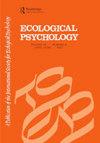Multifractality Versus (Mono-) Fractality as Evidence of Nonlinear Interactions Across Timescales: Disentangling the Belief in Nonlinearity From the Diagnosis of Nonlinearity in Empirical Data
IF 1.7
3区 心理学
Q3 PSYCHOLOGY, EXPERIMENTAL
引用次数: 33
Abstract
ABSTRACT This article addresses the still popular but incorrect idea that monofractal (sometimes called “fractal” for short) structure might be a definitive signature of nonlinearity and, as a corollary, that monofractal analyses are nonlinear analyses. That this point (i.e., “fractal = nonlinear”) is incorrect remains novel to many readers. We suspect that unfamiliarity with autocorrelation has helped eclipse the linearity of fractal structure from more popular appreciation. In this article, in order to explain the linear nature of monofractality and its difference from multifractality, we present an introduction to the autocorrelation function and review short-lag memory, nonstationary motions, and the intermediary set of fractionally integrated processes that conventional fractal analyses quantify. Understanding from our own experiences how surprising the linearity of fractals is to accept, we attempt to make our points clear with as much graphic depiction as math. We hope to share our own experiences in struggling with this potentially strange-sounding idea that, really, monofractals are linear while at the same time contrasting them to multifractals that can indicate nonlinearity.多重分形与(单)分形作为跨时间尺度非线性相互作用的证据:从经验数据中的非线性诊断中解开对非线性的信念
摘要本文提出了一种仍然流行但不正确的观点,即单分形(有时简称“分形”)结构可能是非线性的决定性特征,因此,单分形分析就是非线性分析。这一点(即“分形=非线性”)是不正确的,对许多读者来说仍然是新奇的。我们怀疑,对自相关的不熟悉有助于掩盖分形结构的线性,使其不受人们的欢迎。在本文中,为了解释单分形的线性性质及其与多重分形的区别,我们介绍了自相关函数,并回顾了短滞后记忆、非平稳运动和传统分形分析量化的分数积分过程的中间集合。根据我们自己的经验,我们理解分形的线性是多么令人惊讶,我们试图通过与数学一样多的图形描述来阐明我们的观点。我们希望分享我们自己在与这种听起来可能很奇怪的想法作斗争时的经验,即单分形实际上是线性的,同时将其与可能表明非线性的多重分形进行对比。
本文章由计算机程序翻译,如有差异,请以英文原文为准。
求助全文
约1分钟内获得全文
求助全文
来源期刊

Ecological Psychology
PSYCHOLOGY, EXPERIMENTAL-
CiteScore
3.30
自引率
10.50%
发文量
8
期刊介绍:
This unique journal publishes original articles that contribute to the understanding of psychological and behavioral processes as they occur within the ecological constraints of animal-environment systems. It focuses on problems of perception, action, cognition, communication, learning, development, and evolution in all species, to the extent that those problems derive from a consideration of whole animal-environment systems, rather than animals or their environments in isolation from each other. Significant contributions may come from such diverse fields as human experimental psychology, developmental/social psychology, animal behavior, human factors, fine arts, communication, computer science, philosophy, physical education and therapy, speech and hearing, and vision research.
 求助内容:
求助内容: 应助结果提醒方式:
应助结果提醒方式:


